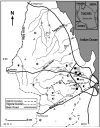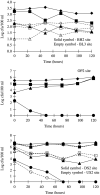Sorbitol-fermenting Bifidobacteria are indicators of very recent human faecal pollution in streams and groundwater habitats in urban tropical lowlands
- PMID: 20375476
- PMCID: PMC2875850
- DOI: 10.2166/wh.2010.116
Sorbitol-fermenting Bifidobacteria are indicators of very recent human faecal pollution in streams and groundwater habitats in urban tropical lowlands
Abstract
Sorbitol-fermenting Bifidobacteria (SFB) proved to be an excellent indicator of very recent human faecal pollution (hours to days) in the investigated tropical stream and groundwater habitats. SFB were recovered from human faeces and sources potentially contaminated with human excreta. SFB were undetectable in animal faeces and environmental samples not contaminated with human faeces. Microcosm studies demonstrated a rapid die-off rate in groundwater (T90 value 0.6 days) and stream water (T90 value 0.9-1.7 days). Discrimination sensitivity analysis, including E. coli, faecal coliforms, total coliforms and Clostridium perfringens spores, revealed high ability of SFB to distinguish differing levels of faecal pollution especially for streams although high background levels of interfering bacteria can complicate its recovery on the used medium. Due to its faster die-off, as compared to many waterborne pathogens, SFB cannot replace microbiological standard parameters for routine water quality monitoring but it is highly recommendable as a specific and complementary tool when human faecal pollution has to be localized or verified. Because of its exclusive faecal origin and human specificity it seems also worthwhile to include SFB in future risk evaluation studies at tropical water resources in order to evaluate under which situations risks of infection may be indicated.
Figures

 , Polluted water; ◐ Tap water; DRC, Democratic Republic of Congo.
, Polluted water; ◐ Tap water; DRC, Democratic Republic of Congo.

Similar articles
-
Sorbitol-fermenting bifidobacteria as indicators of diffuse human faecal pollution in estuarine watersheds.J Appl Microbiol. 1999 Oct;87(4):528-35. doi: 10.1046/j.1365-2672.1999.00845.x. J Appl Microbiol. 1999. PMID: 10583680
-
Bifidobacterial survival in surface water and implications for microbial source tracking.Can J Microbiol. 2009 Jun;55(6):642-7. doi: 10.1139/w09-007. Can J Microbiol. 2009. PMID: 19767833
-
Sorbitol-fermenting bifidobacteria as specific indicators of human faecal pollution.J Appl Bacteriol. 1983 Oct;55(2):349-57. doi: 10.1111/j.1365-2672.1983.tb01331.x. J Appl Bacteriol. 1983. PMID: 6654767
-
[Microbial indicators and fresh water quality assessment].Ann Ist Super Sanita. 2005;41(3):353-8. Ann Ist Super Sanita. 2005. PMID: 16552126 Review. Italian.
-
[Surface water pollution and microbiological indicators].Ann Ist Super Sanita. 2005;41(3):359-70. Ann Ist Super Sanita. 2005. PMID: 16552127 Review. Italian.
Cited by
-
Sanitary inspection of wells using risk-of-contamination scoring indicates a high predictive ability for bacterial faecal pollution in the peri-urban tropical lowlands of Dar es Salaam, Tanzania.J Water Health. 2012 Jun;10(2):236-43. doi: 10.2166/wh.2012.117. J Water Health. 2012. PMID: 22717748 Free PMC article.
-
Assessing the faecal source sensitivity and specificity of ruminant and human genetic microbial source tracking markers in the central Ethiopian highlands.Lett Appl Microbiol. 2021 Apr;72(4):458-466. doi: 10.1111/lam.13436. Epub 2020 Dec 24. Lett Appl Microbiol. 2021. PMID: 33300161 Free PMC article.
-
New molecular quantitative PCR assay for detection of host-specific Bifidobacteriaceae suitable for microbial source tracking.Appl Environ Microbiol. 2012 Aug;78(16):5788-95. doi: 10.1128/AEM.00895-12. Epub 2012 Jun 8. Appl Environ Microbiol. 2012. PMID: 22685136 Free PMC article.
-
Have genetic targets for faecal pollution diagnostics and source tracking revolutionized water quality analysis yet?FEMS Microbiol Rev. 2023 Jul 5;47(4):fuad028. doi: 10.1093/femsre/fuad028. FEMS Microbiol Rev. 2023. PMID: 37286726 Free PMC article.
References
-
- APHA . Standard Methods for the Examination of Water and Wastewater. 19th edition American Public Health Association/American Water Works Association/Water Environmental Federation; Washington, DC: 1995.
-
- Byamukama D, Mach RL, Kansiime F, Manafi M, Farnleitner AH. Discrimination efficacy of fecal pollution detection in different aquatic habitats of a high altitude tropical country using presumptive coliform, Escherichia coli and Clostridium perfringens spores. Appl. Environ. Microbiol. 2005;71(1):65–71. - PMC - PubMed
Publication types
MeSH terms
Substances
Grants and funding
LinkOut - more resources
Full Text Sources
Medical

